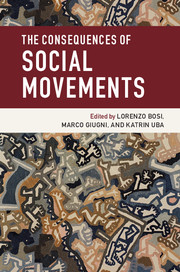Book contents
- Frontmatter
- Contents
- List of figures
- List of tables
- List of contributors
- Introduction
- Part I People
- Part II Policies
- 7 Protest against school closures in Sweden: accepted by politicians?
- 8 Feminist mobilization and the politics of rights
- 9 Reputation, risk, and anti-corporate activism: how social movements influence corporate outcomes
- 10 Tactical competition and movement outcomes on markets: the rise of ethical fashion
- Part III Institutions
- Conclusion
- Index
- References
7 - Protest against school closures in Sweden: accepted by politicians?
from Part II - Policies
Published online by Cambridge University Press: 05 January 2016
- Frontmatter
- Contents
- List of figures
- List of tables
- List of contributors
- Introduction
- Part I People
- Part II Policies
- 7 Protest against school closures in Sweden: accepted by politicians?
- 8 Feminist mobilization and the politics of rights
- 9 Reputation, risk, and anti-corporate activism: how social movements influence corporate outcomes
- 10 Tactical competition and movement outcomes on markets: the rise of ethical fashion
- Part III Institutions
- Conclusion
- Index
- References
Summary
Scholars studying the consequences of social movements have usually focused on movements and activists (Amenta et al. 2010; Giugni 1998). Recently, however, more attention has been paid to targets, who are usually policy makers, and to their motives for listening to contentious actions (e.g., Luders 2006). These studies assume that targets respond to protests on the basis of their rational interest in reelections and stability. Others argue that authorities’ responses depend on the perceived legitimacy and worthiness of mobilization (e.g., Tilly 1999). Although these propositions are not mutually exclusive, current scholarship has paid little attention to how authorities actually look upon protest actions. If we assume that targets are more responsive to movements that use strategies they understand and consider legitimate, then it is important to investigate which forms of protest are seen as more or less legitimate. For instance, activists are sometimes concerned about radical groups, whose actions can undermine the legitimacy of their non-disruptive protest strategies. But how warranted is this concern? The few prior studies on targets’ attitudes toward protests do not answer this question, because these studies treat all protest strategies as the same type of action. This treatment may be misleading, because the character of petitioning and letter-writing in media is clearly different from that of demonstrations, strikes, occupation of public buildings, or activists’ visits to politicians’ homes. More disruptive actions also have different political consequences than less disruptive ones (Luders 2006; Uba 2005). On the other hand, studies that examine the outcomes of different protest strategies and relate them to the novelty, militancy, variety, size, and cultural resonance of these actions (see more in Taylor and van Dyke 2004), have not related the question of effectiveness to targets’ attitudes toward different protest strategies. This chapter does relate protest effectiveness to targets’ attitudes, and suggests that this approach helps us better understand why political context plays a role in the varying outcomes of disruptive protests.
The chapter examines how targets’ attitudes toward different forms of protest vary among Swedish decision-makers, and which kinds of targets tend to be more understanding toward petitioning or occupations of public buildings. Mass-level studies show that an individual's approval of a protest action is related to her personal background and to the disruptiveness of the experienced events (Crozat 1998).
- Type
- Chapter
- Information
- The Consequences of Social Movements , pp. 159 - 184Publisher: Cambridge University PressPrint publication year: 2016
References
- 11
- Cited by



